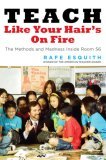Teach Like Your Hair’s on Fire
By Murray Bourne, 28 Aug 2007
The Methods and Madness Inside Room 56
by Rafe Esquith, Viking, NY, 2007.

Education is mostly broken. Broken by governments that don't get it; broken by school systems that encourage mediocrity; broken by a society that values goods over values; and broken by a culture that demands instant gratification.
And then along comes a special teacher - someone who strongly believes that students can and must learn. And learn not only the 3 Rs, but the things that really matter.
I immediately warmed to Teach Like Your Hair's on Fire. While the context is grade 5 & 6 elementary school, the approach is remarkably relevant to all levels of education.
Level VI
Esquith's career has been built on a simple but powerful foundation: encourage students to aspire to the highest of Kohlberg's Six Levels of Moral Development (pp18-22).
Level I: I don't want to get into trouble.
Level II: I want a reward.
Level III: I want to please somebody.
Level IV: I want to follow the rules.
Level V: I am considerate of other people.
Level VI: I have a personal code of behaviour and I follow it.
Esquith has been a teacher for over 20 years in a large elementary school in downtown LA. Most of the students are from a non-English speaking background and many come from homes that are poor, dysfunctional, violent or simply not supportive of schools.
But through modeling level VI behavior and getting his students to study many examples of people exhibiting Level VI maturity, the students slowly get it.
The code that Esquith requires of his students:
Be nice. Work hard.
The classroom wall is emblazoned with:
There are no shortcuts.
Esquith's 5th grade classroom is full of enthusiastic hard workers. But the students don't complain because there is genuine learning going on. His students score well in the plethora of standardized tests plaguing the American school system, but not because they are prepped for the test. No, the students are believed in and in turn, they learn.
Some of the book's gems
There are some great lessons in this book for parents, teachers, students, homeschoolers and governments.
Some of the many things that jumped out at me:
- Students are encouraged to be genuine scientists (not just to follow a cook book approach to science classes). Apparently in the US, very few elementary classrooms do any science at all. (p96)
- Students are allowed to learn from failure - now there's a concept (p102)
- Teachers should get out of the way and let students get on with it (p109)
- Sports and sportsmanship are an important part of learning
- The students experience a kind of "classroom Monopoly", where they use a "currency" and learn some important lessons about renting & buying of property and delayed gratification (p133)
- The students perform a different Shakespeare play every year, complete with modern music performed by the students (their troupe is called the Hobart Shakepeareans after the school's name.
- Rejection of materialistic pop culture, especially those elements that glorify violence
- An emphasis on respect
- The problem solving "Bible"
The "Bible" referred to in the last dot point is a simple strategy that helps the students confidently approach problems in mathematics (and other situations). He contrasts the method with teachers who say "Use your head" or "Read it again" - which doesn't help anyone.
Disturbing Issues Raised
Some worrying things in the book:
- To be an effective educator, you have to have super-hero powers: Esquith is at school by 6:30 am; teaches all day; must have little time for his own 4 children; must be constantly poor (since he spends a lot of his own money to support his programs); produces a Shakespeare play once every year (which is a killer, I know from experience...); and must be constantly close to burnout (which I also know from experience).
- Esquith's descriptions of so many things that are wrong in education (the violence, the time-wasting, the endless educational fads that come and go, the corruption in standardized tests, etc)
- The vandalism and violence inflicted on these students on a weekly basis
Recommendation
This is an inspiring book. Esquith's work has won him many awards and well-deserved recognition.
We can believe in students - we must believe in them so that they've got a hope of reaching their potential.
Resources
- The official Hobart Shakespeareans site.
- Wikipedia on Rafe Esquith.
- There's even a PBS Movie.
- Esquith and Robert Fried share a common vision, but are coming from different angles. See The Game of School.
Be the first to comment below.
